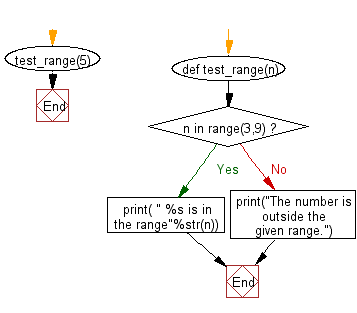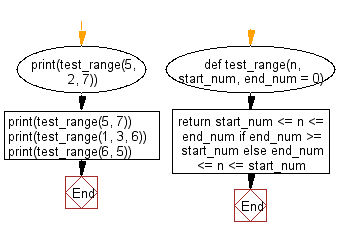Python Exercise: Check whether a number falls in a given range
Python Functions: Exercise-6 with Solution
Write a Python function to check whether a number falls in a given range.
Sample Solution-1:
Python Code:
def test_range(n):
if n in range(3,9):
print( " %s is in the range"%str(n))
else :
print("The number is outside the given range.")
test_range(5)
Sample Output:
5 is in the range
Pictorial presentation:
Flowchart:

Visualize Python code execution:
The following tool visualize what the computer is doing step-by-step as it executes the said program:
Sample Solution-2:
- Use arithmetic comparison to check if the given number is in the specified range.
- If the second parameter, end, is not specified, the range is considered to be from 0 to start.
Python Code:
def test_range(n, start_num, end_num = 0):
return start_num <= n <= end_num if end_num >= start_num else end_num <= n <= start_num
print(test_range(5, 2, 7))
print(test_range(5, 7))
print(test_range(1, 3, 6))
print(test_range(6, 5))
Sample Output:
True True False False
Flowchart:

Visualize Python code execution:
The following tool visualize what the computer is doing step-by-step as it executes the said program:
Python Code Editor:
Have another way to solve this solution? Contribute your code (and comments) through Disqus.
Previous: Write a Python function to calculate the factorial of a number (a non-negative integer). The function accepts the number as an argument.
Next: Write a Python function that accepts a string and calculate the number of upper case letters and lower case letters.
What is the difficulty level of this exercise?
Test your Programming skills with w3resource's quiz.
Python: Tips of the Day
Find current directory and file's directory:
To get the full path to the directory a Python file is contained in, write this in that file:
import os dir_path = os.path.dirname(os.path.realpath(__file__))
(Note that the incantation above won't work if you've already used os.chdir() to change your current working directory, since the value of the __file__ constant is relative to the current working directory and is not changed by an os.chdir() call.)
To get the current working directory use
import os cwd = os.getcwd()
Documentation references for the modules, constants and functions used above:
- The os and os.path modules.
- The __file__ constant
- os.path.realpath(path) (returns "the canonical path of the specified filename, eliminating any symbolic links encountered in the path")
- os.path.dirname(path) (returns "the directory name of pathname path")
- os.getcwd() (returns "a string representing the current working directory")
- os.chdir(path) ("change the current working directory to path")
Ref: https://bit.ly/3fy0R6m
- New Content published on w3resource:
- HTML-CSS Practical: Exercises, Practice, Solution
- Java Regular Expression: Exercises, Practice, Solution
- Scala Programming Exercises, Practice, Solution
- Python Itertools exercises
- Python Numpy exercises
- Python GeoPy Package exercises
- Python Pandas exercises
- Python nltk exercises
- Python BeautifulSoup exercises
- Form Template
- Composer - PHP Package Manager
- PHPUnit - PHP Testing
- Laravel - PHP Framework
- Angular - JavaScript Framework
- Vue - JavaScript Framework
- Jest - JavaScript Testing Framework
